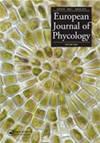Species delimitation within the colonial flagellates Uroglena, Uroglenopsis and Urostipulosphaera (Chrysophyceae)
IF 1.7
4区 生物学
Q2 MARINE & FRESHWATER BIOLOGY
引用次数: 6
Abstract
ABSTRACT Until recently, there was no agreement on species delimitation within the morphologically similar chrysophycean genera Uroglena, Uroglenopsis and Urostipulosphaera. In this study, we aimed at a modern taxonomic revision based on the combination of morphological characters (ultrastructure of cysts, cell and colony features) and a multigene phylogeny (SSU, ITS rDNA and rbcL sequences), with ecology taken into account. Of more than 650 explored localities, only approximately one in 10 hosted a viable and detectable population of these colonial chrysophytes at the time of sampling. We established and examined 189 short-term cultures along with single colony isolates, derived mostly from blooming or encysting populations. We obtained the cyst morphology for four species and two lineages of Uroglena, two species of Uroglenopsis, and four species of Urostipulosphaera. A total of 12 resolved lineages could be attributed to previously described species or new species (Uroglena imitata sp. nov., Urostipulosphaera granulata sp. nov.). Based on our molecular analyses and morphological observations, we assign all the previously described Uroglena-like taxa to newly recognized genera and propose a key to identification. Consequently, Uroglena now includes 16 species and two varieties, Uroglenopsis contains four species and Urostipulosphaera encompasses nine species. Within Uroglena and Urostipulosphaera, species are defined by the ultrastructure of their cysts. On the contrary, as Uroglenopsis has simple cysts, species are defined by cell and colony characteristics.鞭毛纲尿藻目、尿藻目和尿藻目的种界划分
摘要直到最近,在形态相似的温藻属Uroglena、Uroglenopsis和Urostipulosphaera中,还没有就物种划界达成一致。在这项研究中,我们旨在根据形态学特征(包囊的超微结构、细胞和菌落特征)和多基因系统发育(SSU、ITS rDNA和rbcL序列)的组合,并考虑生态学,对现代分类学进行修订。在650多个已探索的地区中,只有大约十分之一的地区在采样时拥有这些殖民地温生植物的存活和可检测种群。我们建立并检测了189种短期培养物和单菌落分离物,这些分离物主要来源于开花或包壳种群。我们获得了四种和两个谱系的Uroglena、两种Uroglenopsis和四种Urostipulosphaera的囊肿形态。共有12个已解析的谱系可归属于先前描述的物种或新种(Uroglena mimoda sp.nov.,Urostipulosphaera graneta sp.nova.)。基于我们的分子分析和形态学观察,我们将所有先前描述的Uroglena-like分类群分配给新识别的属,并提出了鉴定的关键。因此,Uroglena现在包括16个物种和两个变种,Uroglonopsis包括4个物种,Urostipulosphaera包括9个物种。在Uroglena和Urostipulosphaera中,物种由其囊肿的超微结构来定义。相反,由于眼窝炎有简单的囊肿,物种是由细胞和菌落特征决定的。
本文章由计算机程序翻译,如有差异,请以英文原文为准。
求助全文
约1分钟内获得全文
求助全文
来源期刊

European Journal of Phycology
生物-海洋与淡水生物学
CiteScore
4.80
自引率
4.20%
发文量
37
审稿时长
>12 weeks
期刊介绍:
The European Journal of Phycology is an important focus for the activities of algal researchers all over the world. The Editors-in-Chief are assisted by an international team of Associate Editors who are experts in the following fields: macroalgal ecology, microalgal ecology, physiology and biochemistry, cell biology, molecular biology, macroalgal and microalgal systematics, applied phycology and biotechnology. The European Journal of Phycology publishes papers on all aspects of algae, including cyanobacteria. Articles may be in the form of primary research papers and reviews of topical subjects.
The journal publishes high quality research and is well cited, with a consistently good Impact Factor.
 求助内容:
求助内容: 应助结果提醒方式:
应助结果提醒方式:


